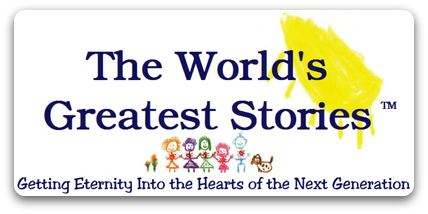
The Prophets. Shadrach, Meshach and Abednego. Daniel. Elijah. Jonah. Powerful stories of faith and courage from the Old Testament. Beloved stories that take me straight back to Sunday School as a child.
Our family was given (to review) Volume 1, The Prophets, part of the CD series from
The World's Greatest Stories.
I requested and was given the NIV version. I had no idea what to expect. The description explained that the stories are told straight from the NIV Bible. That could mean really, really good
or just plain dry and boring.
I am relieved and pleased to report that storyteller and actor George W. Sarris gives five
fantastic performances bringing the stories from the NIV Bible to life with different voices and accents that are quite entertaining. The stories are enhanced with music, sound effects and special effects. Interesting fact: In the FAQ of
The World's Greatest Stories website, I learned that Mr Sarris memorizes the performance before he records it.
The stories range in length from 8-14 minutes. The CD we received has five stories, is available in King James or NIV versions, in cassette or CD, and is priced at $7.95.
The audio stories are
very.
well.
done. I would have
loved them as a child. I love them now. The stories take me there. The accents differentiate characters from one another in a way that I can keep track of who's who. Music is used effectively underneath the story to add to the emotional component of the stories. When I am listening to the stories, I am there. I hear the fire in the furnace crackling (the sound effects are perfect) and I can almost feel the heat. I hear the seagulls near Jonah; I can almost smell the sea air. I hear the fear in the minds of the men on the boat with Jonah. I see it all in my mind in a way that I have not before, despite reading these passages from the Bible many times over the years.
SPECIAL NEEDS PERSPECTIVEMy big concern (and I chose not to allow my homeschooler hear
this CD -yet- for this very reason) is the fact that these stories are scary. Hear me out. My homeschooler developed anxiety around going to Sunday School and Vacation Bible School. Her memories are of stories at SS and VBS about Esther, where the king wanted to kill all of her people, or about pounding nails into the hands and feet of Jesus. Scary stuff to a young child or an older child with developmental delays.We had trouble getting her into the church building for a while - she was afraid. Until she is better able to put the pieces of the story into proper perspective, I am not ready to give her an audio story with men being thrown into a furnace or a man being thrown to the lions yet.
I would consider ordering two of the CDs for her.
The Life of Christ seems (as I look at story titles) to have less of the scary stuff;
Joseph & His Brothers is familiar (a sib was in a production of
Joseph and the Amazing Technicolor Dreamcoat a few years ago).
The pace of the story is faster than I'd like for my child. The speech therapist evaluating her believes she comprehends everything, but her auditory processing speed is slower than typical; she needs more pauses and processing time than the CD allows. She screeches in protest when we talk to fast for her to process. (I would love to see a slowed-down version of this for her. I don't know if that is possible.) If your child has auditory processing challenges, a
sample on the World's Greatest Stories may help you evaluate whether these are appropriate for your situation.
As I consider how I could begin to use these CDs with my girl, I think that she would enjoy an audio story of a topic that she already knows well (and that has fewer scary moments). If your child is like mine, needs that strong visual component and has the auditory processing challenges, introducing a CD with very loved and familiar stories may be a successful first step into the world of audio stories.
If you have a child who insists on familiar pronunciations, you may find some of the pronunciations new or different. One is
Darius -
du RI us vs the familiar-to-me
DAR ee us.
Thinking beyond special needs and aheadThe stories contain a lot of 'new' vocabulary, words and terms we don't use every day, words worth logging in a definitions journal.
The CD is something I'd pack in the car for a long or short ride. And it's something to pop in at home while coloring or playing with clay or play dough or building a marble run or with Lego. It's also something I'd consider buying to donate to a Sunday School class. And my nieces and nephews would adore them, I think.
The CD is something I'd consider for a Sunday morning at home. Every have a Sunday where you're snowed in or you're staying home w/ a sick child? This would make a neat home-church option on one of those Sundays.
Among my friends are folks who are from the Jewish faith and some who are atheists. This particular CD (and the other Old Testament stories) is appropriate for families who are not Christian.
Thumbs up - the stories are quite entertaining and a true to scripture. The price is right, too.
See what my Crewmates' think about
The World's Greatest Stories here.
The World's Greatest Stories sent me a CD to review for you. I was not paid for this review (I get to keep the CD) and am not obligated to provide a positive review.
 Explaining menstruation and puberty and all of the changes that happen to a daughter with developmental delays is challenging. All of the books I have seen are written for typically developing girls, meaning with more words and text than I'd like, with visuals that are not as in-depth as I'd like for my visual learner.
Explaining menstruation and puberty and all of the changes that happen to a daughter with developmental delays is challenging. All of the books I have seen are written for typically developing girls, meaning with more words and text than I'd like, with visuals that are not as in-depth as I'd like for my visual learner.



















